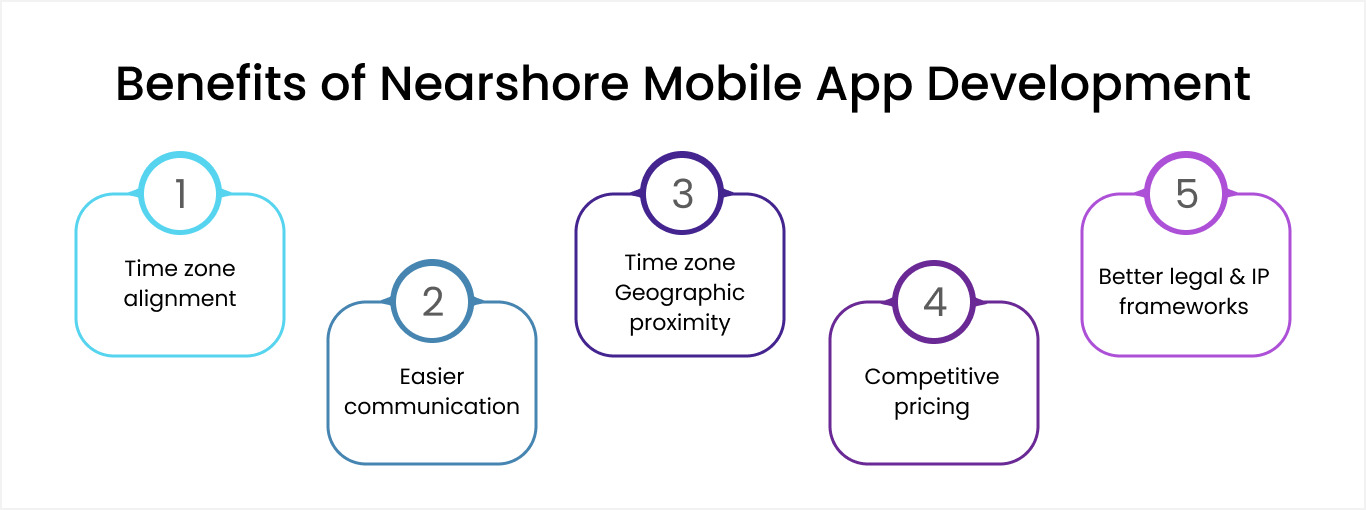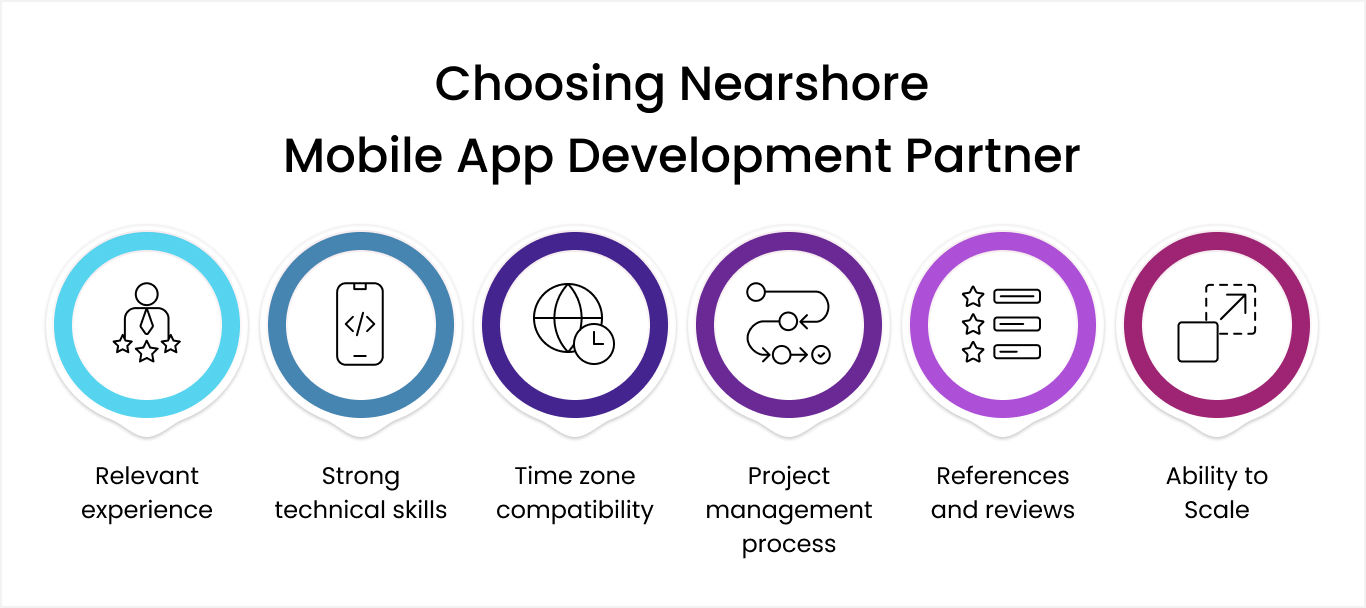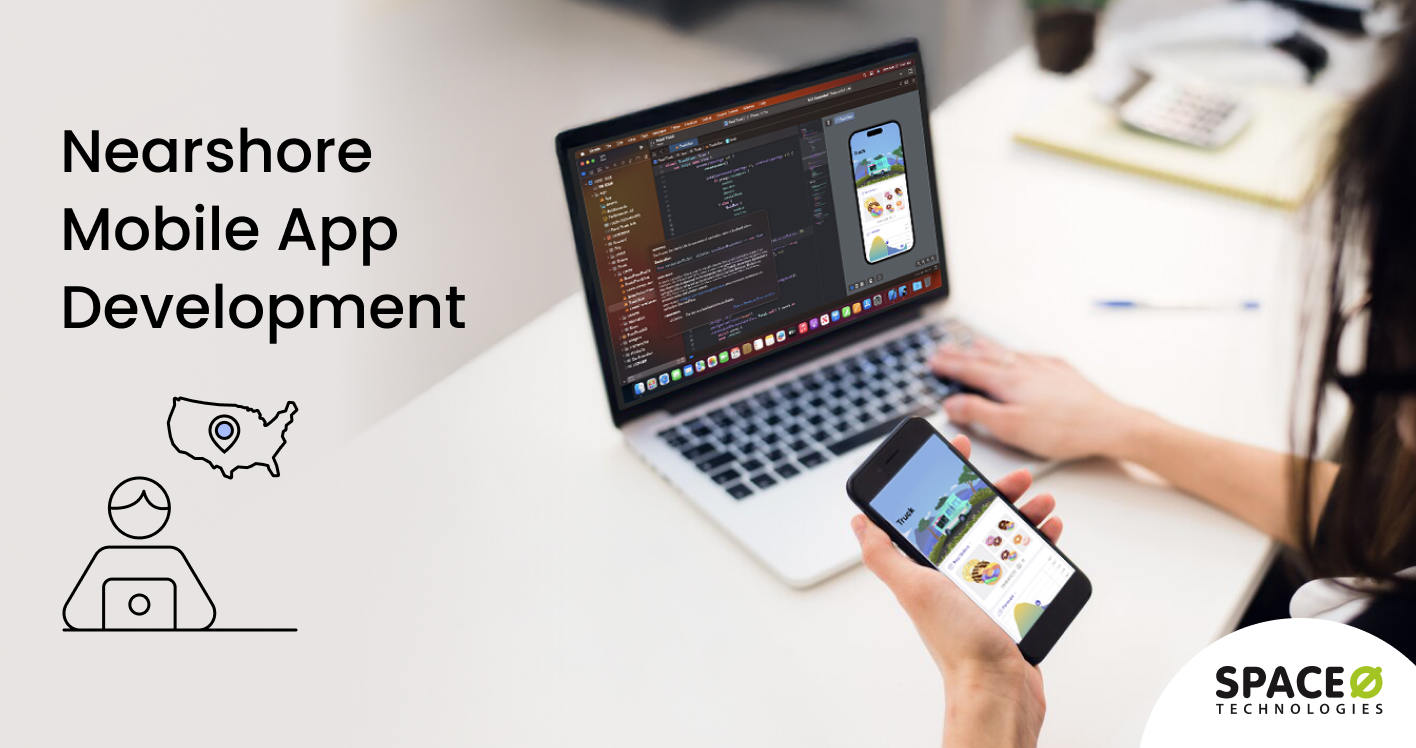Contents
Building a mobile app locally in the U.S. or Canada sounds great—until you see the cost. Hiring local developers can run $100–$150+ per hour in major tech hubs like San Francisco or Toronto.
Meanwhile, offshore outsourcing offers lower rates, but it also brings its headaches: delayed feedback, language barriers, and time zone conflicts that slow everything down.
That’s why more companies are turning to nearshore mobile app development. This outsourcing model strikes a balance between affordability and real-time collaboration with both internal and external teams, helping you avoid developer burnout.
In this guide, you’ll learn what nearshore development is, when to consider it, how much it costs, and how to choose the right mobile app development partner to make your mobile app a success.
Let’s get started.
What is Nearshore Mobile App Development?
Nearshore mobile app development is a type of outsourcing where companies partner with development teams in neighboring or nearby countries, within the same or a similar time zone. It’s a strategic middle ground between onshore and offshore outsourcing models.
For example, if you’re a company based in the U.S., nearshore locations would include Mexico, Colombia, Argentina, or even Canada. These teams can work in real-time with your internal staff, hop on same-day calls, and adapt to your project management style. Unlike offshore partners in regions like India or the Philippines, where time zones and workflows often mismatch, they can work effectively.
Instead of paying $100–$150 per hour for local developers, working with the right nearshore development partner often gives you access to professional developers with deep expertise across mobile platforms, ensuring a secure working relationship and consistent quality assurance.
Nearshore vs. Onshore vs. Offshore: Quick Comparison
| Development Model | Time Zone Overlap | Average Hourly Rate (USD) | Ideal Use Case |
|---|---|---|---|
| Onshore (U.S.) | Full overlap | $100–$150+ | Regulated industries, close team collaboration |
| Nearshore (LATAM) | 4–8 hours overlap | $40–$80 | Agile sprints, fast feedback, and daily standups |
| Offshore (India) | Minimal overlap | $20–$40 | Cost-driven MVPs, non-urgent long-term work |
With nearshore mobile app development, you get the responsiveness of a local team, without the price tag. It’s the smart middle path between quality, cost, and speed.
Now that you know what nearshore mobile app development is, the next question is—why choose it over onshore or offshore models?
Why Choose Nearshore Mobile App Development?

Here’s why more U.S. businesses are choosing nearshore mobile partners in countries like Mexico, Colombia, and Argentina:
Work in real time with teams in your time zone
Nearshore teams reduce time zone differences, enabling real-time collaboration through project management tools like Jira and Slack. You don’t have to wait hours (or days) for feedback, approvals, or updates. Instead, you can:
- Jump on quick calls
- Make same-day decisions
- Keep your development cycle moving smoothly
Communicate easily with culturally aligned teams
Successful app development requires constant communication from requirement gathering to design feedback to iteration loops.
Nearshore outsourcing helps overcome cultural barriers by working with nearshore developers who share similar business practices and a compatible communication style.
- Fewer misunderstandings or language barriers
- Clearer documentation and reporting
- A more collaborative, agile workflow
Stay close to a geographically nearby team
Whether you’re based in the U.S. or Canada, working with a nearby partner makes collaboration feel more accessible.
- Travel is easier for in-person sessions
- Time-sensitive issues can be resolved quickly
- On-site visits (if needed) don’t require complicated planning
Even if your collaboration stays virtual, knowing your team is just a short flight away adds peace of mind.
Get high-quality development at a lower cost
Nearshoring offers a cost-efficient way to build your app without compromising on quality or timelines.
Countries like Mexico, Colombia, and even Canada provide access to skilled developers at rates that support long-term scalability. With nearshore mobile development, you not only get cost savings, but also ongoing post-launch support that’s harder to guarantee with offshore-only setups.
Space-O Technologies delivers even more value with our hybrid model, combining the benefits of nearshoring with the pricing of offshore.
Stronger legal protections and IP security
Many nearshore destinations offer legal systems, IP protections, and business practices that align well with those of the U.S. and Canada. This makes it easier to:
- Draft enforceable contracts
- Protect intellectual property
- Ensure compliance throughout the project lifecycle
For businesses that want the benefits of nearshore development without the steep hourly rates there’s also the option of working with partners who offer a nearshore-like experience, even if they’re technically offshore.
Establishing a secure working relationship with a trusted nearshore development team ensures that your app meets compliance and security needs from the start.
At Space-O Technologies, for example, although our core development team is based in India, we have structured our processes to ensure seamless collaboration for our North American clients. This includes a U.S.-based point of contact, time zone overlap for key meetings, and agile workflows that mirror nearshore responsiveness.
It’s a practical way to reduce costs while still getting the speed, clarity, and partnership experience that nearshoring promises. And for our Canadian clients, we function as a true nearshore partner, combining proximity with proven delivery.
How Much Does Nearshore Mobile App Development Cost?
When it comes to nearshore mobile application development, costs generally fall between $40 to $80 per hour, depending on the country you’re outsourcing to and the complexity of the app.
For example, app development outsourcing costs in Mexico or Colombia may offer more affordable rates than the U.S. or Canada but are still higher than traditional offshore locations like India or the Philippines.
General range for outsourcing nearshore mobile application development
| Region | Approx. Hourly Rate (USD) |
|---|---|
| U.S. (onshore) | $100 – $150+ |
| Canada (nearshore to U.S.) | $75 – $120 |
| Latin America | $40 – $80 |
| India (offshore) | $20 – $40 |
| Space-O Hybrid Model | $20 – $40 |
Note: Rates vary based on experience level, engagement model, and project complexity.
Top Nearshore Locations for Mobile App Development
Here’s a breakdown of the top nearshore locations for U.S businesses building mobile apps – based on workforce readiness, business environment, and tech maturity.
Mexico
Mexico remains one of the top nearshore destinations for U.S.-based companies due to its geographic proximity and time zone alignment. Cities like Guadalajara, Monterrey, and Mexico City are thriving tech hubs, home to a fast-growing base of mobile app developers.
According to the OECD, Mexico’s digital economy is expanding rapidly, with strong support from the public and private sectors to grow ICT capabilities.
Colombia
Colombia has become a strategic tech outsourcing hub in Latin America, thanks to its focus on digital innovation and government-backed tech initiatives. The country offers a young, tech-savvy workforce and modern infrastructure in cities like Bogotá and Medellín.
As per ProColombia, Colombia’s IT sector exports have been growing steadily, supported by favorable policies for international collaboration and investment in the technology sector.
Brazil
With one of the largest pools of software developers in Latin America, Brazil offers a mature tech ecosystem, strong mobile development expertise, and reliable infrastructure.
The World Bank highlights Brazil’s continued investment in innovation and its growing prominence as a regional leader in technology and digital services.
Canada
For U.S. companies that need high-touch collaboration and tight legal alignment, Canada is the closest nearshore partner both geographically and operationally. It offers a highly skilled workforce, advanced infrastructure, and strong IP protection laws.
As reported by Innovation, Science and Economic Development Canada (ISED), Canada’s ICT sector includes over 48,700 companies and continues to be one of the top exporters of technology services.
When Should You Choose Nearshore Mobile App Development?
While outsourcing mobile app development makes sense in many situations, nearshore development is ideal when you need speed, alignment, and cost-efficiency without losing control.
Here are the most common scenarios where nearshore makes the most impact:
You’re racing against time to launch your MVP
If you’re under pressure to get your product to market fast, nearshore teams can help you kick off in days and iterate rapidly with same-day communication and feedback.
Your in-house team is at capacity (or lacks mobile expertise)
A dedicated team of nearshore mobile app developers can step in to support mobile application development across Android development, iOS development, and cross-platform solutions, letting your in-house team focus on core priorities.
You need agile sprints and real-time collaboration
For fast-moving projects, being able to work in sync with your dev team matters. Nearshore teams in Latin America or Canada share your work hours, making daily standups and sprint reviews frictionless.
You want better quality than offshore, but lower costs than local
Nearshore software development offers a practical path for businesses seeking a balance between the affordability of offshore development and the responsiveness of local teams.
You’re building a pilot or prototype and want flexibility
If you’re testing a product idea or stakeholder demo, a nearshore team can help you build, iterate, and pivot quickly without committing to a long-term full-time team.
You need to scale development without long hiring cycles
With nearshore partners, you gain access to pre-vetted software developers without having to endure lengthy recruitment processes, helping you build and scale mobile applications quickly.
Need a Mobile App Developer Now?
Tight deadline? No in-house bandwidth? Our nearshore-aligned team is ready to jump in and help you build, iterate, and launch—fast.

How to Choose the Right Nearshore Mobile App Development Partner

In the process of finding the right nearshore mobile app development partner, you’re choosing a long-term collaborator. Someone who understands your goals, fits your work style, and can deliver quality results. Here’s a deeper look at the key factors to consider:
Relevant experience with a similar mobile app
Start by looking at the partner’s portfolio. Have they worked on mobile apps similar to what you’re building? Whether in terms of features, target audience, or industry. For example, if you’re developing a healthcare app, a team that’s already familiar with HIPAA compliance and secure data handling will be a huge asset. Do they have relevant experience in the mobile app development process?
Go through the case studies, client success stories, and app store links to see what they’ve shipped.
Strong technical skills across platforms
Make sure the team has hands-on experience with the right platforms and tools:
- For iOS, look for Swift and Objective-C.
- For Android, they should be well-versed in Kotlin and Java.
- For cross-platform, check for Flutter, React Native, or Xamarin experience.
You should also ask about their approach to backend integrations, cloud services, and testing. A solid development partner won’t just code; they’ll help architect your entire mobile experience from front to back.
Overlapping time zones for seamless collaboration
Even within the nearshore model, time zones can vary. Ideally, your team should overlap with at least 4 hours of your working day. That allows time for daily check-ins, sprint planning, or issue resolution without waiting overnight for a reply.
Time zone alignment means fewer delays, faster approvals, and tighter collaboration, especially during design reviews and quality assurance (QA).
Structured project management process
A reliable development partner will have a transparent process in place. Ask them:
- Do they use Agile or Scrum?
- How often do they run sprints?
- How do they handle change requests or scope updates?
- What tools do they use (e.g., Jira, Trello, Slack)?
You want a team that follows structured workflows, offers transparency into progress, and gives you control over priorities and deadlines.
References, reviews, and client satisfaction
Don’t skip this step. Ask for 2–3 references you can speak to directly. This gives you insight into:
- How the team performs under pressure.
- How they handle bugs, delays, or pivots.
- Whether previous clients would work with them again.
Also, check their reviews on platforms like Clutch, GoodFirms, or G2 for social proof.
Ability to scale with your growth
You may be starting with a small MVP app development, but what happens if you raise funding or need to launch new features quickly? Ensure your partner can scale the team based on your project’s needs without slowing you down or compromising quality.
Get Transparent Pricing for Your App Development
We offer affordable, quality mobile app development without the typical offshore delays or complications.
Platform Capabilities to Expect from a Nearshore Mobile Team
Whether you’re targeting mobile devices in North America with iOS development or launching globally with Android development, your nearshore team should be able to recommend the best key strategy for your target platforms.
With cross-platform tools, nearshore teams can quickly develop MVPs or internal tools that offer high performance without compromising on user experience ideal for businesses needing fast and successful deployment.
iOS App Development (Swift, Objective-C)
If your primary audience is in North America or Western Europe and especially if you’re targeting high-income consumers, enterprise users, or tech-savvy professionals, developing an iOS app should be a top consideration.
Look for a team that can offer:
- Proficiency in Swift and Objective-C
- Adherence to Apple’s Human Interface Guidelines
- Experience with native features like Apple Pay, ARKit, and HealthKit
- Extensive testing across iPhones and iPads to ensure smooth performance
The right nearshore iOS team will help you deliver a secure and polished iOS experience aligned with Apple’s design and performance standards.
Use Case Example:
-
For healthcare apps, iOS is ideal for building HIPAA-compliant features, integrating wearable data (via HealthKit), and targeting Apple Watch users.
Android App Development (Kotlin, Java)
Android is a smart choice if your app targets a global or emerging market audience, especially in regions like Latin America, Southeast Asia, or Africa. It’s also a strong fit for operational apps in sectors like logistics, field services, and transportation.
Key capabilities to expect:
- Deep knowledge of Kotlin and legacy support for Java
- Custom UI development for diverse device sizes and brands
- Integration with Google services like Maps, Firebase, and Google Pay
- Tested across a range of Android devices to manage fragmentation
Use Case Example:
-
For logistics and fleet management apps, Android is often preferred due to affordability, GPS compatibility, and easier device deployment at scale.
A capable nearshore Android team ensures consistency, speed, and reliability in Android app development, no matter where your users are or what device they’re using.
Cross-Platform App Development (Flutter, React Native)
Suppose your goal is to launch on both iOS and Android quickly without managing two codebases. In that case, cross-platform development offers the best value, especially for MVPs, internal tools, or apps with tight timelines.
Use cases include:
- Startups validating a new product
- Businesses rolling out internal apps
- Projects with limited budgets or aggressive launch goals
Top cross-platform teams will:
- Use modern frameworks like Flutter or React Native
- Share code across platforms without sacrificing the native feel
- Follow performance optimization best practices
- Avoid common pitfalls like bloated app sizes or UI inconsistencies
Use Case Example:
-
For startups launching marketplaces or social platforms, using Flutter allows faster iteration, unified UI components, and quick scalability.
A nearshore partner with cross-platform expertise can accelerate development, reduce costs, and still deliver a high-quality user experience across both ecosystems.
Nearshore App Development With Space-O Technologies: Why Partner With Us?
While nearshore mobile app development is ideal for teams seeking time zone alignment, clear communication, and faster turnaround, not every business can afford the high hourly rates typically associated with nearshore destinations like Canada or Latin America.
Our delivery model is designed to give you the benefits of a nearshore team agile collaboration, real-time feedback, cultural compatibility while operating at offshore pricing. We achieve this by combining:
That’s where Space-O Technologies offers a practical alternative. Here’s how:
- A U.S.-based point of contact to ensure smooth, local communication
- A flexible collaboration window that overlaps with North American business hours
- A highly experienced development team in India, delivering top-tier mobile apps at 30–50% lower cost
For clients in Canada, this model qualifies as nearshore by definition, offering both proximity and performance. For U.S.-based clients, it’s a cost-effective way to simulate a nearshore experience without nearshore rates.
This hybrid setup is especially effective for:
- MVPs that require fast build and launch cycles
- Long-term agile projects where real-time feedback is essential
- Businesses need to scale development teams without long hiring delays
300+ apps delivered | 40+ U.S. clients | 97% satisfaction rate
Whether you’re building an MVP or scaling a complex product, our development process ensures consistent output, fewer blockers, and faster go-to-market cycles.
Looking for nearshore efficiency without nearshore rates? Let’s make it happen. Contact Space-O Technologies to get started on your mobile app development today.
Frequently Asked Questions
How long does it take to build a mobile app?
Mobile app development takes 4–6 weeks for an MVP, 2–4 months for a mid-sized app, and 4–6 months or more for a complex product when developed with a nearshore team.
Thanks to overlapping time zones and smoother communication, nearshore teams help accelerate development timelines compared to offshore setups, especially during feedback loops and sprint execution.
What makes nearshore mobile app development better than offshore?
Nearshore teams offer:
- Real-time collaboration (same/similar time zones)
- Better cultural alignment and communication
- Faster feedback loops and reduced rework
While offshore models may offer lower rates, nearshore typically results in higher quality and quicker delivery.
How is nearshore mobile app development different from outsourcing in general?
Nearshore development is a subset of outsourcing. While general outsourcing can include partners anywhere in the world, nearshoring refers explicitly to working with vendors in neighboring or nearby countries, typically within the same time zone, to improve coordination and reduce project friction.
Is nearshore development suitable for startups?
Yes. Nearshore development is an excellent fit for startups and early-stage companies that need to move quickly, collaborate closely, and stay within a limited budget. It allows startups to scale rapidly without having to build a whole in-house team.
Is intellectual property protection a concern with nearshore development?
Not if you work with the right partner. Reputable nearshore teams—especially those serving North American clients—follow strong legal protocols to protect your code, data, and ideas.
At Space-O, we sign NDAs, include IP clauses in all contracts, and ensure your source code is 100% owned by you.
What are the risks of nearshore mobile app development?
Here are the risks associated with the nearshore mobile app development:
- Misalignment in work style or development process
- Limited availability of niche skill sets in some regions
- Fluctuations in regional pricing or talent retention
Working with an experienced partner like Space-O Technologies mitigates the challenges of nearshore mobile app development.
What are the best practices for successful nearshore mobile app development?
The most effective nearshore partnerships follow best practices like clear communication, agile workflows, and continuous testing.
To get the most out of nearshore mobile app development, it’s essential to:
- Establish consistent communication channels (e.g., Slack, Zoom) for real-time collaboration
- Document requirements before starting to avoid scope creep
- Adopt Agile or Scrum methodologies for flexibility and iterative delivery
- Encourage cross-functional collaboration between your in-house and nearshore teams
- Maintain rigorous QA/testing protocols to ensure performance and stability



